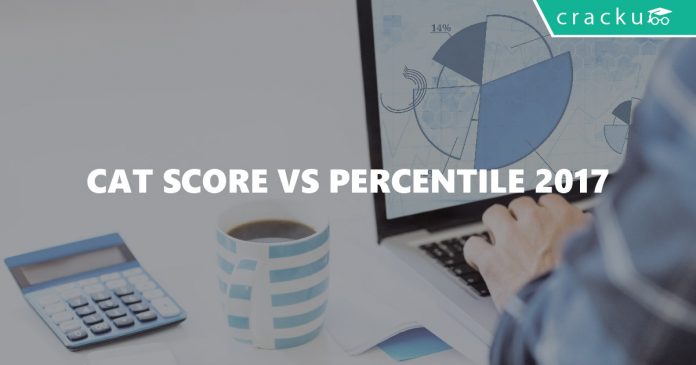CAT 2018 was announced to be conducted by IIM Calcutta on Nov 25, 2018. As is the case with most competitive exams, it is the relative performance that matters in CAT. Before the euphoria settles, let us have a look at the actual cut off of CAT 2017. In this article, we try to give you an actual CAT 2017 score vs percentile mapping so as to have some idea on how much to score in CAT 2018.
CAT Score Vs Percentile
What is CAT Percentile?
- Let us start by defining what a percentile means. A percentile gives you the percentage of test takers scoring equal to or less than the candidate in the exam. This is the definition that CAT follows.
- The next thing to know is scaling. As the examination is conducted across various slots, it is nearly impossible to replicate the exact difficulty of the exam over slots. Therefore, CAT authorities carry out a process called normalization to ensure fairness.
- CAT adopts equi-percentile method to normalize the scores of the candidates. The scores so obtained are termed as scaled scores. The scaled scores may either increase or decrease depending on the performance of the fellow test takers in the slot.
CAT Slot-1 & Slot-2 Exam Analysis
CAT 2017 score vs percentile mapping:
(Actual Percentile mapping)
The DILR section was a bit tougher as compared to CAT 2016. The other 2 sections were slightly easier in comparison.
Historically, a score over 60% has proved to be a safe bet for 99 percentile. A score over 50% can more or less place a candidate over 95th percentile. As the exam was on the tougher side, a score of 50% can prove sufficient for a few IIM calls.
| Percentile | Overall score |
| 80 | 93 |
| 85 | 105 |
| 90 | 118 |
| 95 | 139 |
| 98 | 160 |
| 99 | 174 |
| 99.5 | 185 |
| 99.7 | 202 |
| 99.9 | 209 |
| 100 | 230 |
Now, let us have a look at CAT score vs percentile 2016.
CAT 2017 Questions & Solutions
XAT Previous papers with solutions
CAT 2016 score vs percentile mapping:
| Percentile | Overall score |
| 80 | 83 |
| 85 | 92 |
| 90 | 104 |
| 95 | 123 |
| 98 | 143 |
| 99 | 156 |
| 99.5 | 167 |
| 99.7 | 174 |
| 99.9 | 190 |
| 100 (least) | 220 |
- The quant section was significantly tougher as compared to 2015. The verbal and DILR sections were fairly similar in the level of difficulty. This resulted in a huge variation in the scores vs percentile mapping. As we can see, the difference was prominent.
- A score of 123 fetched 90th percentile in 2015. Whereas in 2016, the same score fetched 95th percentile. Therefore, aspirants must try to attempt as much as possible in the exam.
- A scaled score of 180 fetched 99th percentile in 2015. The required score in 2016 for 99th percentile was just 156 marks. Therefore, one must avoid going in with a fixed target.
CAT 2015 score vs percentile mapping:
IIMs adopted the 3 section format in 2015. Therefore, let us begin from 2015. Also, the exam pattern has not undergone any drastic changes after 2015. The approximate score vs percentile mapping for CAT 2015 is as follows.
Percentile |
Overall score |
| 80 | 99 |
| 85 | 110 |
| 90 | 123 |
| 95 | 144 |
| 98 | 168 |
| 99 | 180 |
| 99.5 | 193 |
| 99.7 | 202 |
| 99.9 | 220 |
| 100 (least) | 250 |
- A point to note is that the scores in the table are scaled scores (not raw scores). The effect of scaling is high at the higher scores. However, the effect of scaling is more or less negligible at the lower end.
- A score of 123 was enough to attain 90th percentile. An overall score of 144 fetched 95th percentile. 99th percentile was pegged at 180 marks. Also, a score of 200 proved sufficient for 99.7 percentile.
- Aspirants without any blemishes in their acads can expect calls from all the IIMs at this percentile.
CAT 2017 Slot 1 & Slot 2 Exam Analysis
We hope that this article on CAT score vs percentile 2017 was useful to develop some idea about the number of attempts that can be considered safe. For more useful articles, try reading how to improve mock CAT scores and how to get into IIM with poor academics.





![CAT Averages Questions PDF [Important Questions] CAT AVERAGES Questions PDF](https://cracku.in/blog/wp-content/uploads/2022/07/CAT-AVERAGES-Questions-PDF-218x150.png)
[…] You can object any question that you feel the answer is different compared to the given official answer key. Also check your expected marks vs percentile for CAT 2017.. […]